Tāu-suàn (sometimes known as le̍k-tāu-suàn), or split mung beanI soup, is a dessert of Teochew origin. It is a sweet and starchy soup made from split mung beans, usually eaten with iû-tsia̍h-kué (油炸粿; i.e. youtiao). In Singapore, tāu-suàn is a common sight – go to any hawker centre, and chances are, you will find at least one or two dessert stalls selling this dessert.
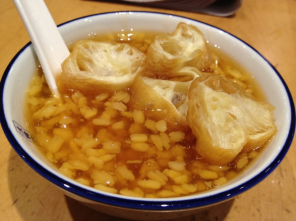
(Source: https://s3-media2.fl.yelpcdn.com/bphoto/gXQQV6EaA9jE9hQFF-TflQ/o.jpg)
In Standard Mandarin, the name of this dessert should be translated as ‘綠豆羹’ (lǜdòugēng), literally ‘green beanI soup’. Indeed, as part of their efforts to spread the usage of ‘proper Mandarin terms’[1][2], the Speak Mandarin Campaign’s encouraged people to use the dessert’s Mandarin name “lǜdòugēng” instead of its Hokkien name ‘tāu-suàn’. Of course, they were unsuccessful, as most people still call it ‘tāu-suàn’ anyway, even when they’re speaking in Mandarin.
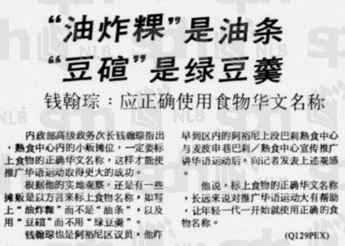
(Source: http://eresources.nlb.gov.sg/newspapers/Digitised/Article/lhzb19861027-1.2.11.11.aspx)
The components making up the Mandarin name is quite clear: ‘綠豆羹’ is made up of ‘綠’ (green), ‘豆’ (bean), and ‘羹’ (soup, specifically thick soup or broth). However, what is the etymology for ‘tāu-suàn’ then? The first syllable, ‘tāu’, is definitely ‘豆’ i.e. bean. But it is the second syllable that has mystified many: suàn. What does it mean? Does it have a corresponding Chinese character?
To answer that question, we need to compare the different ways of writing it in Chinese characters. They include: ‘豆蒜’, ‘豆算’, ‘豆爽’, ‘豆漺’, ‘豆宣’, ‘豆萱’, ’豆碹’, and ‘豆饌’. At first glance, the sheer number of different ways may seem intimidating. However, it actually boils down (no pun intended) to just four different categories.
~~~~~~~
豆蒜 – [豆蒜、豆算]
The oldest attestable way of writing ‘tāu-suàn’ that I could find is ‘豆蒜’, from 1928[3], dating before the Second World War. Similarly, ‘豆算’ can also be attested to around the start of the Second World War, in 1939.[4] I’ve categorised ‘豆蒜’ and ‘豆算’ together, since both ‘蒜’ and ‘算’ are pronounced ‘suàn’ in Hokkien.
Between the two, I believe that ‘豆蒜’ is the original, while ‘豆算’ is a derivation. The ‘蒜’ in ‘豆蒜’ means ‘garlic’. This could be because the yellow, split mung beans in the dessert has a slight resemblance to minced garlic, which is commonly used in Chinese cuisine. ‘豆算’ may have arose later as a variant, since ‘蒜’ and ‘算’ are pronounced the same.
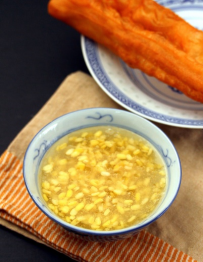
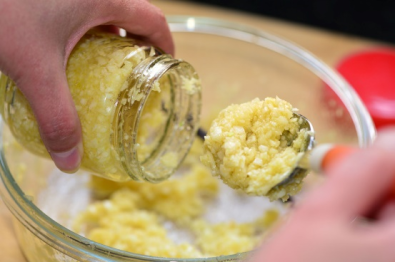
(Sources: http://farm8.staticflickr.com/7314/10601253513_2b3fae3e0d_b.jpg and http://cp2.douguo.net/upload/caiku/2/a/1/yuan_2a5bce13051fa539db302feceeff3cf1.jpg)
There is another Teochew dessert called nôi-tsí-suáng (liân-tsí-suàn in Hokkien) which also shares the same ‘suàn’ syllable. However, it is made from lotus seeds, and does not share the same resemblance with minced garlic with tāu-suàn. Therefore, this explanation is likely an invalid one.
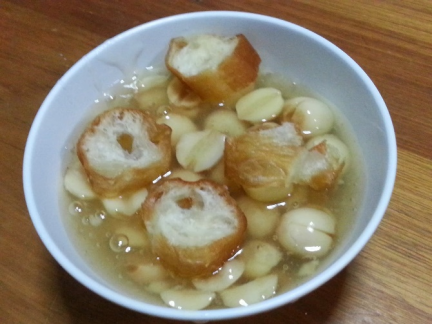
(Source: https://writinginhokkien.files.wordpress.com/2016/10/0d035-1.jpg)
—————
豆爽 – [豆爽、豆漺]
‘豆爽’ is the most common way of writing ‘tāu-suàn’. However, the first attested appearance I could find for ‘豆爽’ was from 1974[5], and its variant ‘豆漺’ from slightly earlier, in 1968[6]. This is surprising, considering how ‘豆蒜’ and ‘豆算’, two non-mainstream ways of writing ‘tāu-suàn’, actually predate ‘豆爽’ by four decades.
In this case, ‘豆漺’ is a variant of ‘豆爽’, with the water radical ‘氵’ added to ‘爽’ to emphasise that it is a kind of soup.
‘爽’ and ‘漺’ are both pronounced ‘sóng’ in Hokkien, which sounds different from the ‘suàn’ in ‘tāu-suàn’. However, in Teochew, these two words are pronounced ‘suáng’, the same as the ‘suàng’ in ‘tāu-suàng’, the Teochew pronunciation for ‘tāu-suàn’. This suggests that ‘豆爽’ / ‘豆漺’ is of Teochew origin. In addition, ‘豆爽’ is also used by Teochews in China[7], and at least one Teochew restaurant uses ‘豆漺’ to write ‘tāu-suáng’, further pointing towards a Teochew origin. This is not surprising, considering how tāu-suàn is ultimately a Teochew dessert.
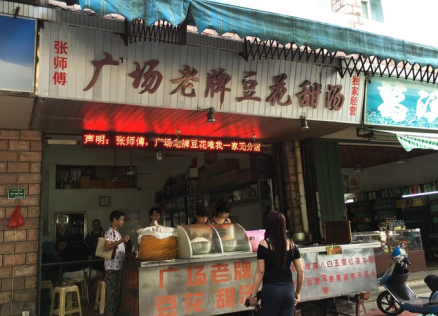
(Source: http://file29.mafengwo.net/M00/62/94/wKgBpVX21taAcCmdAAfAg64_dDY62.groupinfo.w680.jpeg)
‘爽’ also has the meaning of ‘tasty and refreshing’, as in ‘爽口’, which is possibly another reason why ‘豆爽’ is such a prevalent way of writing ‘tāu-suàn’.
Similarly, ‘liân-tsí-suàn’ is commonly written as ‘蓮子爽’, also using the word ‘爽’. Both tāu-suàn and liân-tsí-suàn are sweet, sticky dessert soups, so it is very likely that the meaning of ‘suàn’ is related to this type of soup. However, neither ‘爽’ nor ‘漺’ has the meaning of ‘soup’, so there should be another Chinese character that corresponds to ‘suàn’.
—————
豆碹 – [豆碹、豆宣、豆萱]
‘豆碹’ is another common way of writing ‘tāu-suàn’, together with its variants ‘豆宣’ and ‘豆萱’.
‘碹’ is pronounced as ‘suān’, as in ‘suān-tsio̍hIII’ (碹石) which means ‘diamond’. In Singaporean Hokkien, ‘suān’ and ‘suàn’ are pronounced the same. A folk etymology[8][9] that I found online suggests that the ‘suàn’ in ‘tāu-suàn’ comes from ‘suān’ (diamond), because under bright light the beans in a bowl of tāu-suàn look like sparkling pearls – diamonds – and hence the name. Hence, ‘豆碹’ and its variants are based on this folk etymology.
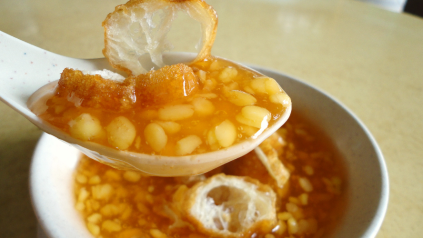
(Source: https://hungryisland.files.wordpress.com/2012/06/dsc03272.jpg)
However, I find that this explanation is flawed. Firstly, it assumes that ‘suān’ can also mean ‘pearl’ besides ‘diamond’, which I have neither encountered nor can I verify anywhere. Also, this explanation does not work for liân-tsí-suàn, since the lotus seeds have a more distinctive shape and does not look like pearls.
—————
豆饌 – [豆饌]
‘豆饌’ is first attested from 1978[10]. ‘饌’ is a literary word, meaning ‘food’. At first glance, it looks as though this could be the Chinese character corresponding to ‘suàn’. However, ‘饌’ is pronounced ‘tsuān’ in Hokkien and ‘tsuǎng’ in Teochew, which does not match. Hence, this is definitely not a possible etymology for ‘suàn’.
~~~~~~~
Conclusion:
When I first begun writing this post, my conclusion was that ‘豆蒜’ were the Chinese characters that corresponded to ‘tāu-suàn’, with the ‘beans look like minced garlic’ explanation. However, since this explanation clearly does not apply to liân-tsí-suàn, I had to change my mind. Hence, the ‘suàn’ in ‘tāu-suàn’ does not come from ‘蒜’.
‘豆碹’ is also not the source of ‘tāu-suàn’. Despite the folk etymology that ‘suàn’ in ‘tāu-suàn’ is related to ‘suān’ in ‘suān-tsio̍hIII’ (diamond), this explanation is forced as I have elaborated earlier.
And ‘豆饌’? Out of the question.
Hence, my conclusion is that ‘豆爽’ or ‘豆漺’ is still the best way to write ‘tāu-suàn’, with my personal preference being the latter. ‘爽’ has the meaning of ‘tasty and refreshing’; add a water radical ‘氵’, and you get a word that can mean ‘tasty and refreshing soup’. However, this is still slightly problematic, as the Hokkien pronunciation ‘爽’ / ‘漺’ does not match ‘suàn’.
That being said, for the time being, I would still recommend using ‘漺’ to write ‘suàn’ i.e. ‘thick soup’. However, I will continue to ask and search around to find a more suitable Chinese character. Also, I am not familiar with Teochew, so if I have made any mistakes, please do correct me in the comments section!
Thank you for reading!
~~~~~~~
Notes
I) ‘mung bean’ is more commonly known as ‘green bean’ in Singapore, possibly a literal translation of ‘綠豆’ (le̍k-tāu). The reason why I specified that tāu-suàn is ‘split mung bean soup’ instead of just ‘mung bean soup’ is bcause there is another type of dessert called ‘le̍k-tāu-thng’, which is also a soup made with mung beans, albeit with unsplit mung beans.
II) Swatow (from Teochew Suann-thâu) is another name for Shantou.
III) ‘suān-tsio̍h’ is written as ‘璇石’ by the Taiwanese Ministry of Education. Their reason behind choosing ‘璇’ can be found here: http://twblg.dict.edu.tw/holodict_new/iongji/pdf/annesia507pdf.pdf
~~~~~~~
References
- 陈婷. (1983, September 26). 突破公共场所讲华语障碍. Lianhe Zaobao, p. 1.
Retrieved from http://eresources.nlb.gov.sg/newspapers/Digitised/Article/lhzb19830926-1.2.2.aspx - “油炸粿” 是油条. “豆碹” 是绿豆羹. (1986, October 27). Lianhe Zaobao, p. 4.
Retrieved from http://eresources.nlb.gov.sg/newspapers/Digitised/Article/lhzb19861027-1.2.11.11.aspx - 新嘉坡山東慘禍籌賑會之鱗爪. 愛國助捐彙紀. (1923, July 14). Nanyang Siang Pau, p. 4.
Retrieved from http://eresources.nlb.gov.sg/newspapers/Digitised/Article/nysp19280714-1.2.11.4.aspx - 小販同業賑分會寒衣捐. 繳星華籌賑大會. 計九百十三元四角二占. (1939, December 6). Nanyang Siang Pau, p. 10.
Retrieved from http://eresources.nlb.gov.sg/newspapers/Digitised/Article/nysp19391206-1.2.103.aspx - 连理. (1974, June 4).賣甜湯的生涯. Nanyang Siang Pau, p. 10.
Retrieved from http://eresources.nlb.gov.sg/newspapers/Digitised/Article/nysp19740604-1.2.31.4.aspx - 可人. (1968, October 2). 潮州甜品. Nanyang Siang Pau, p. 10.
Retrieved from http://eresources.nlb.gov.sg/newspapers/Digitised/Article/nysp19681002-1.2.29.7.aspx - czonline_lh. (2014, January 2). 潮州绿豆爽. czonline.net.
Retrieved from http://csms.czonline.net/chaozhoumeishi/xiaochi/2014-01-02/60988.html - Tau Suan. (2011, August 27).
Retrieved October 13, 2016, from http://kitchentigress.blogspot.sg/2011/08/tau-suan-green-bean-sweet-soup.html - 孔嘉. (1978, April 12). 绿豆馔. Nanyang Siang Pau, p. 20.
Retrieved from http://eresources.nlb.gov.sg/newspapers/Digitised/Article/nysp19780412-1.2.45.12.aspx
~~~~~~~
Correction
- Originally, I had assumed that the Teochew pronunciation for the dessert is ‘tāu-suàng’, with ‘suang’ in the third tone like Hokkien. However, I was corrected by a Teochew speaker who said that it should be ‘tāu-suáng’ instead, with ‘suang’ in the second tone. This means that ‘豆爽/豆漺’ gains further legitimacy as the way to write ‘tāu-suáng’, as the second Chinese character are an exact fit to the pronunciation of the second syllable.I have made the relevant edits. (15 Octover 2016, 3:40p.m.)
